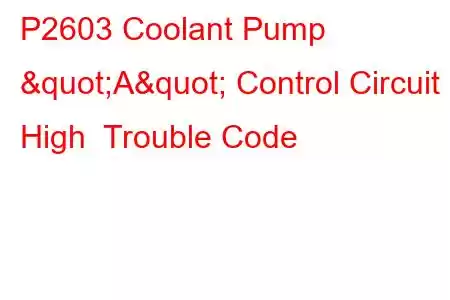Home » P2603-P2699 Codes » P2603 P2603 Coolant Pump A Control Circuit High
OBD-II Trouble Code Technical Description
Coolant Pump "A" Control Circuit High
What does that mean?
This generic powertrain/engine diagnostic trouble code typically applies to all OBDII equipped engines with electric coolant pumps, but shows up more often in certain hybrids vehicles by Ford, Honda, Nissan and Toyota.
The Coolant Pump A (CP-A) is can usually be found mounted to the front of the engine, on top of the engine, inside the wheel wells or against the bulkhead. The CP-A is operated by an electrical signal from the Powertrain Control Module (PCM).
The PCM receives inputs to determine when and how long it needs to operate the CP-A. These inputs are voltage signals received from coolant temp, intake air temp, engine rpm and air conditioning system pressure sensors. Once the PCM has received these inputs it can modify the signal to the CP-A.
P2603 is typically set because of electrical (CP-A circuit) issues. These cannot be overlooked in the troubleshooting stage, especially when dealing with an intermittent problem.
Troubleshooting steps may vary depending upon manufacturer, type of CP-A and wire colors.
Related coolant pump "A" circuit trouble codes:
P2600 Coolant Pump "A" Control Circuit Open P2601 Coolant Pump "A" Range Performance P2602 Coolant Pump "A" Control Circuit LowSymptoms & Severity
Severity is usually severe due to its impact on the cooling system. Because this is usually an electrical failure, the PCM cannot fully compensate for it. Partial compensation usually means that the cooling fans operate all the time (100% duty cycle).
Symptoms of a P2603 code may include:
Malfunction Indicator Light On Overheating A/C system not functioning properlyCauses
Potential causes for this code to set are:
Open in the circuit to the Coolant Pump - likely Failed Coolant Pump - likely Failed PCM - unlikelyDiagnostic and Repair Procedures
A good starting point is always to check for technical service bulletins (TSB) for your particular vehicle. Your issue may be a known issue with a known fix put out by the manufacturer and can save you time and money during diagnosis.
Next, locate the Coolant Pump B (CP-A) on your particular vehicle. This pump is usually found mounted to the front of the engine, on top of the engine, inside the wheel wells or against the bulkhead. Once located, visually inspect the connector and wiring. Look for scraping, rubbing, bare wires, burn spots or melted plastic. Pull the connector apart and carefully inspect the terminals (the metal parts) inside the connector. See if they look burned or have a green tint indicating corrosion. Use electrical contact cleaner and a plastic bristle brush if cleaning of the terminals is needed. Let dry and apply electrical grease where the terminals contact.
If you have a scan tool, clear the diagnostic trouble codes from memory, and see if P2603 code returns. If it does not, then the connections were most likely your problem.
For this particular code, this is the most common area of concern, as are the relays / connections to the relays, with a pump failure second.
If the code does return, we will need to test the pump and the associated circuits. Typically, there are 2 wires at each coolant pump. First, disconnect the harness going to the coolant pump. With a Digital Volt Ohm Meter (DVOM), connect one lead of the meter to one terminal of the pump. Connect the remaining meter lead to the other pump terminal. It should not be open or shorted. Verify the resistance specifications for your particular vehicle. If the pump motor is either open or shorted (infinite resistance or no resistance/0 ohms), replace the coolant pump.
Read: 23


